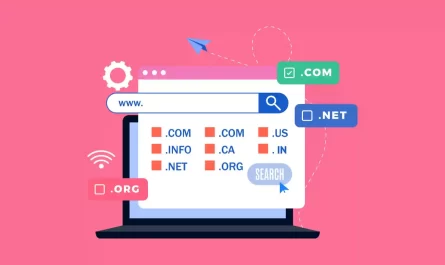In the vast landscape of the internet, domain names play a crucial role in establishing an online presence. They are not only web addresses but also reflections of your brand, identity, or interests. One popular domain extension that has gained attention in recent years is the .blog domain name. If you’re considering registering a .blog domain, here’s all you need to know to make an informed decision.
Table of Contents
- What is a .blog Domain?
- Why Choose a .blog Domain?
- Selecting the Right .blog Domain Name
- Registering a .blog Domain
- Domain Management and Hosting
- Content Creation and Blogging Tips
- SEO and Visibility for Your .blog Website
- Protecting Your .blog Domain
- Conclusion: Start Blogging with .blog
1. What is a .blog Domain?
A .blog domain is a specific type of top-level domain (TLD) designed for bloggers and content creators. It was introduced to provide a dedicated online space for individuals, businesses, and organizations to share their thoughts, ideas, and content with the world. The .blog TLD was created to help bloggers establish a unique online identity and instantly convey the purpose of their website.
2. Why Choose a .blog Domain?
There are several compelling reasons to consider a .blog domain for your website:
- Instant Recognition: The .blog extension instantly communicates the purpose of your website to visitors, making it clear that your site is a blog or a platform for sharing content.
- Memorability: A .blog domain can be more memorable and catchy, making it easier for readers to recall your web address.
- Brand Identity: It can enhance your brand identity, especially if you’re a blogger or content creator. A .blog domain is a great choice for personal branding.
- SEO Benefits: While the TLD itself doesn’t directly impact your search engine ranking, a .blog domain can signal to search engines that your site is focused on content creation, potentially benefiting your SEO efforts.
- Availability: .com domains are often saturated, making it challenging to find a suitable name. .blog domains offer more opportunities to secure a relevant and appealing domain.
- Community: .blog domains are part of a growing community of bloggers and content creators. Using this TLD can connect you with others who share your interests.
3. Selecting the Right .blog Domain Name
Choosing the right domain name is a critical step in building your online presence. Here are some tips for selecting a .blog domain name:
- Be Descriptive: Ideally, your domain name should give visitors an idea of what your blog is about. If you’re blogging about travel, for example, consider a name like “TravelAdventures.blog.”
- Keep It Short and Memorable: Shorter domain names are easier to remember and type. Aim for a name that is concise and catchy.
- Avoid Hyphens and Numbers: Hyphens and numbers can make a domain name more challenging to remember and share. Stick to letters.
- Research Availability: Use domain registration services to check the availability of your desired .blog domain. Be creative if your first choice is taken.
- Consider Your Audience: Think about your target audience and what they might find appealing and easy to remember.
4. Registering a .blog Domain
To register a .blog domain, follow these steps:
- Select a Domain Registrar: Choose a reputable domain registrar that offers .blog domains. Popular options include GoDaddy, Namecheap, and WordPress.com.
- Check Availability: Use the registrar’s search tool to see if your desired .blog domain is available. If it is, you can proceed to register it.
- Registration Process: Registering a .blog domain is similar to registering other domains. You’ll need to provide your contact information, select the desired domain name, and choose the registration period (usually one year).
- Renewal: Keep in mind that domain registration is not a one-time cost. You’ll need to renew your .blog domain annually to maintain ownership.
- Privacy Protection: Consider opting for domain privacy protection (WHOIS privacy) to keep your personal information private.
5. Domain Management and Hosting
After registering your .blog domain, you’ll need to manage it effectively and choose a hosting platform for your blog. Here’s what you should consider:
- Domain Management: Use the registrar’s tools to manage your domain settings, including DNS (Domain Name System) records, name server configurations, and domain forwarding.
- Content Management System (CMS): Select a CMS like WordPress, Blogger, or other blogging platforms to create and manage your content. Many domain registrars offer hosting and CMS options.
- Hosting: Consider whether you want to host your blog on your own server, use a web hosting service, or utilize a blogging platform that includes hosting as part of the package.
- Custom Email: Many registrars provide options for setting up custom email addresses using your domain name (e.g., contact@yourblog.blog).
6. Content Creation and Blogging Tips
Creating engaging content is crucial to the success of your blog. Here are some blogging tips:
- Consistency: Publish content regularly to keep your audience engaged.
- Quality: Focus on creating high-quality, informative, and engaging content that provides value to your readers.
- SEO: Learn about search engine optimization (SEO) to make your content more discoverable on search engines.
- Engage with Your Audience: Respond to comments and engage with your readers through social media and other channels.
- Promotion: Promote your blog through social media, email newsletters, and other marketing strategies.
7. SEO and Visibility for Your .blog Website
To ensure your .blog website is visible to your target audience, consider these SEO and visibility tips:
- Keyword Research: Identify relevant keywords related to your blog’s content and incorporate them into your posts.
- Optimize Images: Use descriptive file names and alt tags for images to improve accessibility and SEO.
- Mobile Optimization: Ensure your blog is mobile-friendly as many visitors access websites via mobile devices.
- Site Speed: Optimize your site for fast loading times to improve user experience and SEO rankings.
- Internal and External Links: Include both internal links to your own content and external links to authoritative sources to enhance credibility and SEO.
8. Protecting Your .blog Domain
Protecting your .blog domain is vital to maintaining your online presence. Here are some security measures to consider:
- Renewal Reminders: Set up reminders to ensure you renew your domain on time to prevent it from expiring.
- Enable Two-Factor Authentication: Many registrars offer two-factor authentication for added security.
- Keep Contact Information Current: Ensure your contact information with the registrar is up-to-date to receive important notifications.
- Backups: Regularly back up your website content to prevent data loss in case of technical issues.
- Malware Scanning: Use website security tools to scan for and prevent malware.
9. Conclusion: Start Blogging with .blog
A .blog domain is an excellent choice for bloggers and content creators looking to establish their online presence. By selecting the right domain name, registering it through a reliable registrar, and following best practices in content creation




